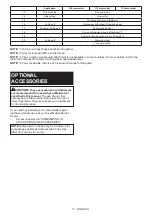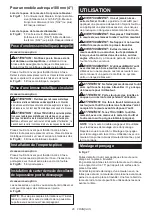
13 ENGLISH
Installing or removing abrasive disc
Optional accessory
NOTE:
Use sander accessories specified in this man
-
ual. These must be purchased separately.
For 100 mm (4″) model
►
Fig.12:
1.
Sanding lock nut
2.
Abrasive disc
3.
Rubber pad
4.
Inner flange
1.
Mount the inner flange onto the spindle.
2.
Mount the rubber pad onto the spindle.
3.
Fit the disc on the rubber pad and screw the sand-
ing lock nut onto the spindle.
4.
Hold the spindle with the shaft lock, and securely tighten
the sanding lock nut clockwise with the lock nut wrench.
To remove the disc, follow the installation procedure in reverse.
For model other than 100 mm (4″)
►
Fig.13:
1.
Sanding lock nut
2.
Abrasive disc
3.
Rubber pad
1.
Mount the rubber pad onto the spindle.
2.
Fit the disc on the rubber pad and screw the sand-
ing lock nut onto the spindle.
3.
Hold the spindle with the shaft lock, and securely tighten
the sanding lock nut clockwise with the lock nut wrench.
To remove the disc, follow the installation procedure in reverse.
Super flange
Optional accessory
Super flange is a special accessory for model which is
NOT equipped with a brake function.
Models with the letter F are standard-equipped with
Super flange. Only 1/3 of efforts needed to undo lock
nut, compared with conventional type.
Installing or removing Ezynut
Optional accessory
Only for tools with M14 spindle thread.
CAUTION:
Do not use Ezynut with Super
Flange. Those flanges are so thick that the entire
thread cannot be retained by the spindle.
Mount inner flange, abrasive wheel and Ezynut onto the
spindle so that Makita Logo on Ezynut faces outside.
►
Fig.14:
1.
Ezynut
2.
Abrasive wheel
3.
Inner flange
4.
Spindle
Press shaft lock firmly and tighten Ezynut by turning the
abrasive wheel clockwise as far as it turns.
►
Fig.15:
1.
Shaft lock
To loosen the Ezynut, turn the outside ring of Ezynut
counterclockwise.
NOTE:
Ezynut can be loosened by hand as long
as the arrow points the notch. Otherwise a lock nut
wrench is required to loosen it. Insert one pin of the
wrench into a hole and turn Ezynut counterclockwise.
►
Fig.16:
1.
Arrow
2.
Notch
►
Fig.17
Installing abrasive cut-off / diamond
wheel
Optional accessory
WARNING:
When using an abrasive cut-off
/ diamond wheel, be sure to use only the special
wheel guard designed for use with cut-off wheels.
WARNING:
NEVER use cut-off wheel for side
grinding.
►
Fig.18:
1.
Lock nut
2.
Abrasive cut-off wheel / dia
-
mond wheel
3.
Inner flange
4.
Wheel guard
for abrasive cut-off wheel / diamond wheel
As for the installation, follow the instructions for
depressed center wheel.
The direction for mounting the lock nut and the inner
flange varies by wheel type and thickness.
Refer to the following figures.
For 100 mm (4″) model
When installing the abrasive cut-off wheel:
►
Fig.19:
1.
Lock nut
2.
Abrasive cut-off wheel
(Thinner than 4 mm (5/32"))
3.
Abrasive cut-
off wheel (4 mm (5/32") or thicker)
4.
Inner
flange
When installing the diamond wheel:
►
Fig.20:
1.
Lock nut
2.
Diamond wheel (Thinner than
4 mm (5/32″))
3.
Diamond wheel (4 mm
(5/32″) or thicker)
4.
Inner flange
For model other than 100 mm (4″)
When installing the abrasive cut-off wheel:
►
Fig.21:
1.
Lock nut
2.
Abrasive cut-off wheel
(Thinner than 4 mm (5/32"))
3.
Abrasive cut-
off wheel (4 mm (5/32") or thicker)
4.
Inner
flange
When installing the diamond wheel:
►
Fig.22:
1.
Lock nut
2.
Diamond wheel (Thinner than
4 mm (5/32″))
3.
Diamond wheel (4 mm
(5/32″) or thicker)
4.
Inner flange
Installing wire cup brush
Optional accessory
CAUTION:
Do not use brush that is damaged,
or which is out of balance.
Use of damaged brush
could increase potential for injury from contact with
broken brush wires.
Place the tool upside down to allow easy access to the
spindle.
Remove any accessories on spindle. Thread wire cup
brush onto spindle and tighten with supplied wrench.
►
Fig.23:
1.
Wire cup brush














































